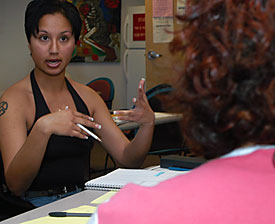 |
|
KEVIN KLAUS/Arizona Daily Wildcat
|
Veronica Martinez, a political science junior, studies in the Chicano/Hispano Student Affairs Center yesterday.
|
|
By Cara O'Connor
Arizona Daily Wildcat
Thursday February 6, 2003
When Krystalyn Kinsel's scholarship money did not arrive on time, the Native American Student Affairs center gave the political science freshman and member of the Navajo tribe an emergency loan to purchase her books.
Many students need loans like this to make it through the school year, said Monica Nuvamsa, senior coordinator of Native American Student Affairs.
Like other multicultural student affairs centers, Native American Student Affairs strives to guide and assist its students, ultimately seeing them through to graduation, Nuvamsa said.
The freshman dropout rate is 23 percent, meaning that half of the students who leave the university do so before the beginning of their second year, according to an Undergraduate Education and Student Research report.
The greater part of minority students never do see graduation, most dropping out their freshman year, according to the 2002 ö 2003 UA Fact Book, but minority student affairs centers are working to change that.
The student affairs centers work closely with the Maximum Educational Results In Two Semesters (MERITS) program, which is designed to acclimate freshman to UA, directors said.
The First Year Academic Support Track (FAST) program in Asian-American Student Affairs works with 73 students, collecting progress reports, helping students communicate with instructors, and providing tutoring and mentoring programs.
"If we can get our students through their first year, the chances of graduating increase significantly," said Alex Wright, Director of African-American Student Affairs.
The student affairs staff commonly provides referrals for students, helping them navigate through the university system, directors said.
"The student is pretty much on her own to ask the right questions, seek resources and find her way to the programs and services set up to help her," said Socorro Carrizosa, director of Chicano/Hispano Student Affairs.
"(African-American Student Affairs) provides you with direction," said James Din, an aerospace engineering senior. An older student may take a new student under his wing and help guide him through his first years at the university, Din said.
Places like the African-American Student Affairs lounge or the Chicano/Hispano Student Affairs computer lab provide further resources for minority students learning to become comfortable with the college life.
"People want to see someone that looks like them. They want to see it in the classroom. They want to see it in the restaurant on campus, and if they don't find it they'll leave," Wright said.
Wright said that the center provides a safe haven for students to connect with people from similar backgrounds.
"Chicano/Hispano Student Affairs is a place where students can go to see familiar faces, " said Sarah Miranda, co-chair of Juntos, an organization that unites representatives from Hispanic clubs and organizations. "You find people there that you can relate to," she said.
About 70 percent of Native American and Hispanic students and 50 percent of African-American students are in the first generation of their families to go to college, according to Wright and Carrizosa.
"Being a first generation college student, your family might not have the same background with all of the nuances of moving through the university system," Wright said.
In most of these situations, the centers work to address financial difficulties that cause problems for many minority students.
Minority students report more economic problems proportionate to the rest of the student body, said Rick Kroc, director of Assessment and Enrollment Research.
Students sometimes have to work three jobs while carrying a full class load, Carrizosa said.
Native American Student Affairs provides emergency loans and the Hispanic Alumni Association offers scholarships to students, but the student affairs centers do not have funding to provide substantial support to all of their students.
"The financial aid system must stop relying on loans and provide more grant money," Carrizosa said, explaining that many families refuse loans because they are afraid of incurring debt.
According to center directors, student affairs centers also work to provide academic support and cultural exploration.
Native American Student Affairs helped to set up the O'odham Ki wing in Graham-Greenlee residence hall, a themed wing devoted to Native American students and their culture.
"It feels like a home away from home," Kinsel said. "When people share the same background as you, they have a really good understanding of who you are because that is who they are, too."

